Lumad
.jpg) A woman in traditional Manobo dress | |
| Total population | |
|---|---|
| Unknown | |
| Regions with significant populations | |
|
CARAGA Davao Region Northern Mindanao SOCCSKSARGEN Zamboanga Peninsula | |
| Languages | |
| Manobo languages, Chavacano (in Zamboanga region), Cebuano, Hiligaynon, Filipino, English | |
| Religion | |
| Christianity (Roman Catholic, Protestant) and Animist | |
| Related ethnic groups | |
| Bajau people, Moro, Visayans, Filipinos, other Austronesian peoples |
| Demographics of the Philippines |
|---|
 |
| Filipinos |
.png)
The Lumad are a group of non-Muslim indigenous people in the southern Philippines. It is a Cebuano term meaning "native" or "indigenous". The term is short for Katawhang Lumad (Literally: "indigenous people"), the autonym officially adopted by the delegates of the Lumad Mindanao Peoples Federation (LMPF) founding assembly on 26 June 1986 at the Guadalupe Formation Center, Balindog, Kidapawan, Cotabato, Philippines.[1] It is the self-ascription and collective identity of the indigenous peoples of Mindanao.
History
The name Lumad grew out of the political awakening among tribes during the martial law regime of President Ferdinand Marcos. It was advocated and propagated by the members and affiliates of Lumad-Mindanao, a coalition of all-Lumad local and regional organizations which formalized themselves as such in June 1986 but started in 1983 as a multi-sectoral organization. Lumad-Mindanao’s main objective was to achieve self-determination for their member-tribes or, put more concretely, self-governance within their ancestral domain in accordance with their culture and customary laws. No other Lumad organization had the express goal in the past.[1]
Representatives from 15 tribes agreed in June 1986 to adopt the name; there were no delegates from the three major groups of the T'boli, the Teduray. The choice of a Cebuano word was a bit ironic but they deemed it appropriate as the Lumad tribes do not have any other common language except Cebuano. This marked the first time that these tribes had agreed to a common name for themselves, distinct from that of the Moros and different from the migrant majority and their descendants.
Ethnic groups
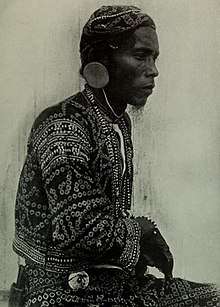
The Lumad are the un-Islamized and un-Christianized Austronesian peoples of Mindanao. They include groups like the Erumanen ne Menuvu', Matidsalug Manobo, Agusanon Manobo, Dulangan Manobo, Dabaw Manobo, Ata Manobo, B'laan, Kaulo, Banwaon, Bukidnon, Teduray, Lambangian, Higaunon, Dibabawon, Mangguwangan, Mansaka, Mandaya, K'lagan, Subanen, Tasaday, Tboli, Mamanuwa, Tagakaolo, Talaandig, Tagabawa, Ubu', Tinenanen, Kuwemanen, K'lata and Diyangan. Considered as "vulnerable groups", they live in hinterlands, forests, lowlands and coastal areas.[2]
The term lumad excludes the Butuanons and Surigaonons, even though these two groups are also native to Mindanao. This is due to their Visayan ethnicity and lack of close affinity with the Lumad. The Moros like the Maranao, Tausug, Sama-Bajau, Yakan, etc. are also excluded, despite being also native to Mindanao and despite some groups being closely related ethnolinguistically to the Lumad. This is because unlike the Lumad, the Moros converted to Islam during the 14th to 15th centuries. This can be confusing, since the word lumad literally means "native" in the Visayan languages.
Blaan
The Blaan is an indigenous group that is concentrated in Davao del Sur and South Cotabato. They practice indigenous rituals while adapting to the way of life of modern Filipinos.[3]
Bukidnon
.jpg)
The Bukidnon are one of the seven tribes in the Bukidnon plateau of Mindanao. Bukidnon means 'that of the mountains or highlands' (i.e., 'people of the mountains or highlands'), despite the fact that most Bukidnon tribes settle in the lowlands. The name Bukidnon itself used to describe the entire province in a different context (it means 'mountainous lands' in this case) or could also be the collective name of the permanent residents in the province regardless of ethnicity.[4]
The Bukidnon people believe in one god, Magbabaya (Ruler of All), though there are several minor gods and goddesses that they worship as well. Religious rites are presided by a baylan whose ordination is voluntary and may come from any sex. The Bukidnons have rich musical and oral traditions[5] which are celebrated annually in Malaybalay city's Kaamulan Festival, with other tribes in Bukidnon (the Manobo tribes, the Higaonon, Matigsalug, Talaandig, Umayamnom, and the Tigwahanon).[6]
The Bukidnon Lumad is distinct and should not be confused with a few indigenous peoples scattered in the Visayas area who are also alternatively called Bukidnon.
Higaonon
The Higaonon is located on the provinces of Bukidnon, Agusan del Sur, Misamis Oriental, Camiguin (used to be Kamiguing), Rogongon in Iligan City, and Lanao del Norte. The Higaonons have a rather traditional way of living. Farming is the most important economic activity.
The word Higaonon is derived from the word "Higad" in the Higaonon dialect which means coastal plains and "Gaon" meaning ascend to the mountains. Taken together, Higaonon, means the people of the coastal plains that ascended to the mountains. Higaonons were formerly coastal people of the provinces as mentioned who resisted the Spanish occupation. Driven to the hills and mountains these people continued to exist and fought for the preservation of the people, heritage and culture.
Mamanwa

The Mamanwa is a Negrito tribe often grouped together with the Lumad. They come from Leyte, Agusan del Norte, and Surigao provinces in Mindanao; primarily in Kitcharao and Santiago, Agusan del Norte,[7] though they are lesser in number and more scattered and nomadic than the Manobos and Mandaya tribes who also inhabit the region. Like all Negritos, the Mamanwas are phenotypically distinct from the lowlanders and the upland living Manobos, exhibiting curly hair and much darker skin tones.
These peoples are traditionally hunter-gatherers[8] and consume a wide variety of wild plants, herbs, insects, and animals from tropical rainforest. The Mamanwa are categorized as having the "negrito" phenotype with dark skin, kinky hair, and short stature.[8][9] The origins of this phenotype (found in the Agta, Ati, and Aeta tribes in the Philippines) are a continued topic of debate, with recent evidence suggesting that the phenotype convergently evolved in several areas of southeast Asia.[10]
However, recent genomic evidence suggests that the Mamanwa were one of the first populations to leave Africa along with peoples in New Guinea and Australia, and that they diverged from a common origin about 36,000 years ago.[11]
Currently, Mamanwa populations live in sedentary settlements ("barangays") that are close to agricultural peoples and market centers. As a result, a substantial proportion of their diet includes starch-dense domesticated foods.[12] The extent to which agricultural products are bought or exchanged varies in each Mamanwa settlement with some individuals continuing to farm and produce their own domesticated foods while others rely on purchasing food from market centers. The Mamanwa have been exposed to many of the modernities mainstream agricultural populations possess and use such as cell phones, televisions, radio, processed foods, etc.[12]
The political system of the Mamanwa is informally democratic and age-structured. Elders are respected and are expected to maintain peace and order within the tribe. The chieftain, called a Tambayon, usually takes over the duties of counseling tribal members, speaking at gatherings, and arbitrating disagreements. The chieftain may be a man or a woman, which is characteristic of other gender-egalitarian hunter-gatherer societies.[13] They believe in a collection of spirits, which are governed by the supreme deity Magbabaya, although it appears that their contact with monotheist communities/populations has made a considerable impact on the Mamanwa's religious practices. They are often taught (by Christian and Catholic rural Pilipinos) that their animistic beliefs are savage. The tribe produce excellent winnowing baskets, rattan hammocks, and other household containers.
Mamanwa (also spelled Mamanoa) means 'first forest dwellers', from the words man (first) and banwa (forest).[14] They speak the Mamanwa language (or Minamanwa).[15] They are genetically related to the Denisovans.[16]
Mandaya
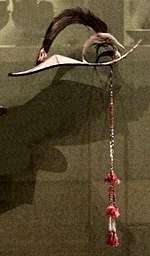
"Mandaya" derives from "man" meaning "first," and "daya" meaning "upstream" or "upper portion of a river," and therefore means "the first people upstream". It refers to a number of groups found along the mountain ranges of Davao Oriental, as well as to their customs, language, and beliefs. The Mandaya are also found in Compostela and New Bataan in Compostela Valley (formerly a part of Davao del Norte Province).
Manobo
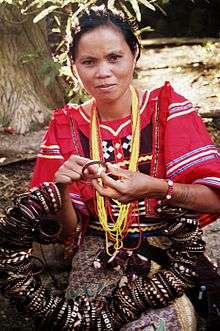
.jpg)
The Manobo are an Austronesian, indigenous agriculturalist population who neighbor the Mamanwa group in Surigao del Norte and Surigao del Sur (Garvan, 1931). They live in barangays like the Mamanwa; however, population size is dramatically larger in the Manobo settlements in comparison to those of the Mamanwa. The two groups interact frequently although the amount of interaction varies between settlements and intermarriage is common between them (Reid, 2009).
Manobo is the hispanicized spelling of Manuvu. Its etymology is unclear; in its current form it means 'person' or 'people'.
The Manobo are probably the most numerous of the ethnic groups of the Philippines in the relationships and names of the groups that belong to this family of languages. Mention has been made of the numerous subgroups that comprise the Manobo group. The total Manobo population is not known, although they occupy core areas from Sarangani island into the Mindanao mainland in the provinces of Agusan del Sur, Davao provinces, Bukidnon, and North and South Cotabato. The groups occupy such a wide area of distribution that localized groups have assumed the character of distinctiveness as a separate ethnic grouping such as the Bagobo or the Higaonon, and the Atta. Depending on specific linguistic points of view, the membership of a dialect with a supergroup shifts.
The Manobo are genetically related to the Denisovans, much like the Mamanwa.[16]
Mansaka
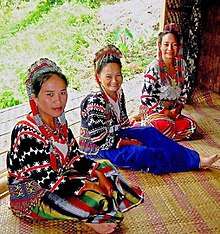
The term "Mansaka" derives from "man" with literal meaning "first" and "saka" meaning "to ascend," and means "the first people to ascend mountains/upstream." The term most likely describes the origin of these people who are found today in Davao del Norte and Davao del Sur. Specifically in the Batoto River, the Manat Valley, Caragan, Maragusan, the Hijo River Valley, and the seacoasts of Kingking, Maco, Kwambog, Hijo, Tagum, Libuganon, Tuganay, Ising, and Panabo.[17]
Sangir
According to the old history (TARSILA) and the narration of the old Sangir tribal leaders, there are two Sangir, or Sangire in the Philippines. First is the Sangir tribe affiliated to Bangsamoro in which since time immemorial they were already existed in their ancestral lands and controlled their ancestral domains and the other one was the Sangir tribe came from Sangir Island in Indonesia to which even as of now they were still belongs to the Indonesian government and citizen.
The Sangir Philippines (Filipo) before the Asia was divided into various country this country had already existed form of government and it was the Sultanate form of government which headed by the Datu`s, Sultan, Papong and tribal chieftains on their respective territory.
But when the Philippine archipelago was discovered by the Spain then eventually they called it Philippines in respect to King Philip and followed by the succeeding colonizers such as Japanese and American forces.
When the Filipino people gained and granted the Philippines as an independent nation from the American government and Mindanao incorporated to the Philippine territory despite of opposition and protest by the Bangsamoro Sultanate in Mindanao and with this, the Bangsamoro people resisted fought to not include their territory to the Republic of the Philippines and Sangir leaders join with the struggle of the Bangsamoro right to self-determination over their ancestral lands and domains.
For a long time ago, the Sangir tribe in the Philippines was never applied for recognition from any government agencies and departments but rather they were continued their struggle in support for Bangsamoro aspiration for right to self-determination.
however in the series of dialogues and forums Mindanao Indigenous Peoples Initiative for Research and Assistance Center, Inc. (MIPIRAC) approached and talked with the Sangir tribe leaders and presented to them that there is an existing laws that protecting their rights over their ancestral lands and domain and it is the Indigenous Peoples Right Act (IPRA) Law.
MIPIRAC now is working closely with Sangir tribe leaders towards the fully recognition of Sangir tribe Indigenous political structures (IPS) in collaboration with Mindanao People`s Peace Movement (MPPM).
They are located in the islands of Balut, Sarangani, Mainland of Jose Abad Santos in Davao Occidental Province and the coastal areas of Sarangani Province such as Kiamba, Maasim, Maitum, General Santos City, Glan and South Cotabato.
Currently upon the results of the Sangir tribe leaders meeting held in General Santos City, they already identified their chief Sultan and unanimously proclaimed that Basar Kahardin will be their supreme Sultan, Al-Haj;Rolly Montaser Sultan of Sangir in the entire Davao Region at the same time deputy supreme Sultan, Sulan Abubakar Bansalao for Davao Occidental, Madanding Ganawan assistant sultan for Davao Occidental, Papong Alvin Mujahireen Sarip Camandon for executive assistant for Greater Davao Area (GDA) Sultan Pagal Colano sultan of Balut Island, Rajah Mudah Dionesio Cortez for Balut island, Sultan Jud Colano spokesperson, Sultan Pindie Colano for Glan Sarangani Province,Hassa Casim Rajah Mudah/spokesman and MIPIRAC Director Joriskie P. Ontong Secretary General.
Subanon
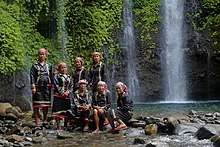
The Subanons are the first settlers of the Zamboanga peninsula. The family is patriarchal while the village is led by a chief called Timuay. He acts as the village judge and is concerned with all communal matters.
History has better words to speak for Misamis Occidental. Its principal city was originally populated by the Subanon, a cultural group that once roamed the seas in great number; the province was an easy prey to the marauding sea pirates of Lanao whose habit was to stage lightning forays along the coastal areas in search of slaves. As the Subanon retreated deeper and deeper into the interior, the coastal areas became home to inhabitants from Bukidnon who were steadily followed by settlers from nearby Cebu and Bohol.
Tagabawa
Tagabawa is the language used by the Bagobo-Tagabawa. They are an indigenous tribe in Mindanao. They live in the surrounding areas of Mt. Apo.[18]
Tagakaulo
Tagakaulo is one of the tribes in Mindanao. Their traditional territories is in Davao Del Sur and the Sarangani Province particularly in the localities of Malalag, Lais, Talaguton Rivers, Sta. Maria, and Malita of Davao Occidental, and Malungon of the Sarangani Province.Tagakaulo means living in mountain. The Tagakaulo tribe originally came from the western shores of the gulf of Davao and south of Mt. Apo.[19] a long time ago.
Tasaday
The Tasaday is a group of about two dozen people living within the deep and mountainous rainforests of Mindanao, who attracted wide media attention in 1971 when they were first "discovered" by western scientists who reported that they were living at a "stone age" level of technology and had been completely isolated from the rest of Philippine society. They later attracted attention in the 1980s when it was reported that their discovery had in fact been an elaborate hoax, and doubt was raised both about their status as isolated from other societies and even about the reality of their existence as a separate ethnic group. The question of whether Tasaday studies published in the seventies are accurate is still being discussed.[20][21]
Tboli
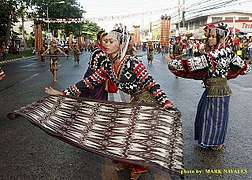
The Tboli are one of the indigenous peoples of South Mindanao. From the body of ethnographic and linguistic literature on Mindanao, they are variously known as Tboli, Teboli, Tau Bilil, Tau Bulul or Tagabilil. They term themselves Tboli. Their whereabouts and identity are to some extent confused in the literature; some publications present the Teboli and the Tagabilil as distinct peoples; some locate the Tbolis to the vicinity of the Buluan Lake in the Cotabato Basin or in Agusan del Norte. The Tbolis, then, reside on the mountain slopes on either side of the upper Alah Valley and the coastal area of Maitum, Maasim and Kiamba. In former times, the Tbolis also inhabited the upper Alah Valley floor.
Languages
The Lumad peoples speak Philippine languages belonging to various branches. These include:
Musical heritage
Most of the Mindanao Lumad groups have a musical heritage consisting of various types of Agung ensembles – ensembles composed of large hanging, suspended or held, bossed/knobbed gongs which act as drone without any accompanying melodic instrument.[22]
Social issues and Lumad killings
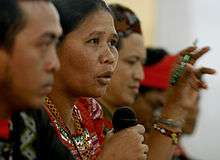
At the beginning of the 20th century (year 1900), the Lumad controlled an area which now covers 17 of Mindanao’s 24 provinces, but by the 1980 census, they constituted less than 6% of the population of Mindanao and Sulu due to a migration policy which served the peoples from Luzon and Visayas, as imposed during the dictatorship of Ferdinand Marcos. Significant migration to Mindanao of Visayans, spurred by government-sponsored resettlement programmes, turned the Lumads into minorities in their own homeland. The Bukidnon province population grew from 63,470 in 1948 to 194,368 in 1960 and 414,762 in 1970, with the proportion of indigenous Bukidnons falling from 64% to 33% to 14%.
Lumad have a traditional concept of land ownership based on what their communities consider their ancestral territories. The historian B. R. Rodil notes that ‘a territory occupied by a community is a communal private property, and community members have the right of usufruct to any piece of unoccupied land within the communal territory.’ Ancestral lands include cultivated land as well as hunting grounds, rivers, forests, uncultivated land and the mineral resources below the land.
Unlike the Moros, the Lumad groups never formed a revolutionary group to unite them in armed struggle against the Philippine government. When the migrants came, many Lumad groups retreated into the mountains and forests. However, the Moro armed groups and the Communist-led New People’s Army (NPA) have recruited Lumad to their ranks, and the armed forces have also recruited them into paramilitary organisations to fight the Moros or the NPA.
For the Lumad, securing their rights to ancestral domain is as urgent as the Moros’ quest for self-determination. However, much of their land has already been registered in the name of multinational corporations, logging companies and other wealthy Filipinos, many of whom, relatively speaking, are recent migrants to Mindanao and key allies of former presidents such as Ferdinand Marcos and Gloria Macapagal Arroyo. Mai Tuan, a T'boli leader explains, "Now that there is a peace agreement for the MNLF, we are happy because we are given food assistance like rice … we also feel sad because we no longer have the pots to cook it with. We no longer have control over our ancestral lands."[23]
The Lumad are people from various ethnic groups in Mindanao island. Residing in their ancestral lands,[24] they are often evicted and displaced due to the Moro people's claim on the same territory.[25] The Lumad have lost parts of their ancestral land due to a failure to understand the modern land tenure system.[26] To counter this, the Lumad established schools in their communities, supplying essential knowledge for the tribe members that would protect their rights, property and culture.[27] However, the Lumad communities are located in mountains that are distant from urban areas. These areas are also the location sites of armed conflict between the New People's Army (NPA) and the Armed Forces of the Philippines (AFP). Caught in the conflict, the Lumad people's education, property, and security are endangered because of the increasing amount of military activity by the armed parties.[26] Increasing military activity have eventually led to the displacement of the communities to shelter sites.[28] Anxiety continues to grow among the Lumad with the escalation of armed conflict and detainment of community leaders (tribe leaders and teachers) labelled as rebels by the military.[29] Alternative schools within the communities (aided by NGOs and universities) face concerns of closing down or demolition of their property, with some buildings converted by the military for their use.[30] Lumad leaders and tribesmen, having experienced political detention due to false suspicions as well as the displacement of their tribes from their areas, have demanded respect for their human rights.[31]
When Gloria Macapagal Arroyo stepped down in 2010 after being President of the Philippines for nine years, she left behind a bloody trail of Lumad killings. Human rights organization Karapatan documented a total of 89 cases of extrajudicial killings of indigenous peoples during the Arroyo administration, and many of these were Lumad.[32]
In response to the killing, detention, and displacement of members of their tribes, the Lumad have organized groups to gain the public's attention, calling for the halt of militarization in their communities. Students, religious leaders, and human rights advocates have supported the Lumad in their movement against the militarization. Activities held to support the Lumad movements have included concerts, cultural festivals (focusing on ethnic culture), and commemoration of Lumad leaders killed in the conflict. Activity leaders have included Fr. Fausto Tentorio, Fr. Tullio Favali, and Fr. Salvatore Carzedda.[33] Groups like the Manilakbayan supported the movements through recruitment and the handing out of national situationers to students to spread awareness about the Lumad's dilemma.[34] The Philippines' Commission on Human Rights (CHR) has been investigating the incidents in regard to the 2015 murder of Lumad leaders and a school official by a paramilitary group called Magahat/Bagani[35] (in line with the idea of CAFGU) created by the AFP to hunt for NPA members. The AFP denies the allegation and attributes the killings to tribal conflict.[36] However, the AFP has admitted that CAFGU has Lumad recruits within its ranks while asserting that the NPA has also recruited Lumad for the group.[37][38] There is also delay of a decision on the CHR investigation due to the noncooperation of the Lumad group after the interruption of the investigation by the spokesman of Kalumaran Mindanao, Kerlan Fanagel. Fanagel insists that the group need not have another 'false' dialogue with the CHR since CHR has yet to present the results/findings of the investigations from the past months when Lumad leaders were killed. Because of the lack of data, CHR decided to postpone the presentation of their initial report to the second week of December 2015.[39]
Since middle of 2016, Lumad killings have risen in the Philippines due to the policies crafted under the administration of president Rodrigo Duterte. In July 12, three Higaonon men were shot and killed by private security forces employed by Ramcar, Inc., in Brgy. Lupiagan, Sumilao, Bukidnon. The killed Higaonons were members of the Sitio Inalsahan Indigenous Peoples Organization, which has an ongoing land dispute with Ramcar, a company engaged in cattle ranching. The site of Ramcar’s ranch is well within the ancestral lands of the Higaonon of Lupiagan.[40] In July 15, only three days after the killings in Sumilao, motorcycle-riding men fired at Bagobo tribal leader Hermie Alegre, 31, in Tugbok district, Davao City. Alegre died en route to the hospital. He was the chairperson of the Kahugpungan sa mga Lumad, an organization of Bagobo people engaged in a land dispute with the religious group Jesus Christ: A Name Above Every Name. The indigenous rights organization PASAKA pointed to the 84th IBPA and the paramilitary group Alamara as perpetrators of the shooting incident.[41]
A pregnant Tigwahanon Manobo woman died and five others were injured when members of the paramilitary group New Indigenous Peoples Army for Reforms (NIPAR) rained bullets on Manobo people celebrating a wedding in the village of Tibugawan, Brgy. Kawayan, San Fernando, Bukidnon on 30July 2016. Butsoy Salusad, the head of NIPAR, has also been tagged as behind the killing of Matigsalog tribal leader Jimmy Liguyon in 2012. An arrest warrant was issued for his arrest, but police and military forces have so far failed to enforce the warrant, and Salusad was even seen together with military and police personnel on different occasions despite the warrant.[42] Two Banwaon indigenous rights activists were also shot dead in separate incidents on 12 August 2016, in the town of San Luis, Agusan del Sur. Jerry Loyola, 42, went to answer a knock on the door of his house in Brgy. Balit and was shot three times in the chest. He died instantly. Not even an hour later, Jimmy Barosa of Brgy. Kasilayan was also shot in the back while taking a rest in front of his house. Both attackers fled on motorcycles afterwards. Both were members of the organization Tagdumahan, which was actively campaigning against the entry of mining and logging companies on Banwaon ancestral territories. Tagdumahan has been tagged by the Philippine Army as supporters of the NPA and its members had been repeatedly harassed by paramilitary groups.[43]
In Compostela Valley, anti-mining activist Jimmy Liguyon was shot by two motorcycle-riding men in the town Montevista in Compostela Valley province on 10 October 2016. Liguyon, a member of the Mandaya tribe, managed to ask for help from bystanders and was rushed to the hospital in Compostela town and then transferred to another hospital in Tagum City, where he died the next day. Liguyon was an officer of the Comval Farmers Association and actively campaigned against entry of the Agusan Minerals and Petroleum Corporation in Compostela town, and was also a critic of the human rights abuses committed by the 66th IBPA.[44] Three days later, another anti-mining Lumad activist was killed in Compostela Valley province. Joselito Pasaporte, a member of the Mansaka tribe and the group Panalipdan Youth, was shot dead in front of the Mabini town cockpit by an unidentified gunman. Police investigators said Pasaporte was number 6 on its druglist and his killing was most probably drug-related. Human rights group Karapatan refuted police claims, saying the military was behind the slaying of Pasaporte because of his stand against large-scale mining.[45] In October 22, Lumad protesters were rammed by a van manned by police officers.[46]
In July 23, 2017, Lumad children wrote a letter to president Duterte to formally halt martial law in Mindanao.[47] On the same day, Duterte threatened to bomb schools used by Lumad children.[48] In July 31, Lumad children again appealed to Duterte, this time so save their schools from military threats.[49] In August 12, the Lumads were met by United Nations special rapporteur for indigenous peoples Victoria Tauli-Corpuz. The visit led to international knowledge on the plight of the Lumad, where the Lumads were affected by wars that aren't theirs. The UN visit was lambasted by president Duterte, who called the United Nations a "son of a bitch".[50] In September 6, another Lumad student, 19-year-old Obillo Bay-ao, was shot dead by a member of a paramilitary group.[51] In November 17, Duterte threatened to bomb Lumad schools again, accusing the Lumads of siding with the communists. Lumad leaders denied such allegations and protested Duterte's threats to bomb indigenous schools in Mindanao.[52] In December 8, pro-indigenous group Karapatan submitted information to the United Nations regarding recent Lumad massacres and forcible evacuations in Mindanao, angering president Duterte. [53]
The letter sent by Karapatan cited the massacre of eight T’boli and Dulangan Manobo farmers who were killed by elements of the 27th and 33rd IBPA in Sitio Datalbong, Brgy. Ned, Lake Sebu, South Cotabato; two others were wounded in the incident. The indigenous peoples were occupying the area langrabbed by the Consunjis, used by their DMCI corporation as a coffee plantation. The said land area, however, is part of the Dulangan Manobo and T’boli ancestral domain. The rights group also raised the series of evacuations affecting different indigenous communities. On November 26, 2017, around 1pm, residents – 1,173 individuals or at least 244 families - from at least nine Lumad communities in Brgy. Diatagon, Lianga and Brgy. Buhisan, San Agustin in Surigao del Sur forcibly evacuated due to military combat operations of the 75th Infantry Battalion-Philippine Army. The number includes 406 Lumad students and 59 teachers of nine Lumad schools. On December 1, 2017, due to the incessant attacks of elements of the 73rd IBPA in Blaan communities, around 210 households have started evacuating from the villages of Lilab, Basyawan, Balataan, Banlas, and Makol, all situated in the boundary of Alabel and Malapatan in Sarangani. In the Northern Mindanao region, at least twenty-one Banwaon families, composed of 139 individuals, from the villages of San Pedro, Binicalan and Mahagsay in San Luis town, Agusan del Sur forcibly evacuated from their communities on December 4, 2017 due to military operations of the 26th Infantry Battalion-Philippine Army.[54] In December 13, a Lumad elementary student came out and told his story regarding Lumad killings. Twelve-year- old Bandam Dumanglay, a Manobo, told a national television network through a formal interview that he witnessed paramilitary and military groups ransacking their homes and schools, burning what little is left of their ancestral domain, and killing his teachers and community leaders one by one.[55]
In February 1, 2018, Duterte told Lumad leaders that the Lumad peoples will be relocated away from their ancestral domains[56], as the government plans to develop Lumad lands using 100 million pesos worth of construction money, which will be operated by multi-million corporations. The statements led to various lightning protests from the Lumad people and concerned sectors.[57] The presidential spokesperson defended Duterte's remarks to "develop" Lumad areas.[58] In February 12, Duterte ordered the Lumad people to "kill" communist insurgents that may enter their ancestral lands. In return for the murders, Duterte promised to give 20,000 pesos for each head killed, causing a major protest from the Lumads as numerous Lumad cultures prohibit murderous acts.[59] In October 5, three Lumad leaders were illegally arrested by elements of the 36th IBPA at Sitio Poog, Maitom, Tandag City, Surigao Sur, around 5 in the morning. Prior to this, the leaders have repeatedly been "invited" by soldiers to the 36th IB HQ without valid reasons.[60]
See also
References
- 1 2 Rodil, Rudy B. "The Tri-People Relationship and the Peace Process in Mindanao". Archived from the original on 5 August 2004. Retrieved 21 October 2017.
- ↑ 31 October 2006, Kidapawan City, Philippines. Contributed by Pependayan, LMPF Secretary General from 1988–1999
- ↑ B’laan women record dreams in woven mats – INQUIRER.net, Philippine News for Filipinos Archived 4 August 2009 at the Wayback Machine.
- ↑ "Bukidnon". Archived from the original on 11 September 2015. Retrieved 10 September 2015.
- ↑ Bukidnon heritage kept alive, Dr. Antonio Montalvan II Archived 25 April 2010 at the Wayback Machine.", inq7.net (accessed through seasite.niu.edu on 3 February 2010)
- ↑ Kaamulan Festival Archived 10 March 2011 at the Wayback Machine.", Bukidnon.gov (accessed 3 February 2010)
- ↑ Anthropology Museum: Mamanwa
- 1 2 Omoto K. 1989. Genetic studies of human populations in Asian-Pacific area with special reference to the origins of the Negritos. In: Hhba H, Hayami I, Michizuki K, orgs. Current Aspects of Biogeography in West Pacific and East Asian Regions. The University Museum, The University of Tokyo, Nature and Culture: 1.
- ↑ Barrows DP. 1910. The negrito and allied types in the Philippines. Am Anthropol 12:358-376.
- ↑ The HUGO Pan-Asian Consortium. 2009. Mapping Genetic Diversity in Asia. Science. 326:1541–1545. http://www.sciencemag.org/content/326/5959/1541.short
- ↑ Pugach, Irina; Delfin, Frederick; Gunnarsdóttir, Ellen; Kayser, Manfred; Stoneking, Mark (2013). "Genome-wide data substantiates Holocene gene ?ow from India to Australia". PNAS. 110 (5): 1803–8. doi:10.1073/pnas.1211927110. PMC 3562786. PMID 23319617.
- 1 2 https://ucsc.academia.edu/EmeraldSnow/Papers/187939/Life-history_reproductive_maturity_and_the_evolution_of_small_body_size_The_Mamanwa_negritos_of_northern_Mindanao
- ↑ Cashdan, E. A. (1980), Egalitarianism Among Hunters and Gatherers. American Anthropologist, 82: 116–120. doi:10.1525/aa.1980.82.1.02a00100 http://onlinelibrary.wiley.com/doi/10.1525/aa.1980.82.1.02a00100/abstract
- ↑ "Agusan-Surigao Historical Archive". Retrieved 10 September 2015.
- ↑ "Mamanwa". Ethnologue. Retrieved 10 September 2015.
- 1 2 Reich, D.; Patterson, N.; Kircher, M.; Delfin, F.; Nandineni, M.R.; Pugach, I.; et al. (2011). "Denisova Admixture and the First Modern Human Dispersals into Southeast Asia and Oceania". The American Journal of Human Genetics. 89 (4): 516–528. doi:10.1016/j.ajhg.2011.09.005. PMC 3188841. PMID 21944045.
- ↑ Fuentes, Vilma May A.; De La Cruz, Edito T. (1980). A Treasure of Mandaya and Mansaka Folk Literature. Quezon City, Philippines: New Day Publishers. p. 2.
- ↑ http://www.joshuaproject.net/people-profile.php?rop3=109689&rog3=RP Joshua Project – Bagobo, Tagabawa of Philippines Ethnic Profile
- ↑ "Tagakaolo". Archived from the original on 25 September 2015. Retrieved 10 September 2015.
- ↑ Shaping and Reshaping the Tasaday: A Question of Cultural Identity—A Review Article, AA Yengoyan – The Journal of Asian Studies, 1991
- ↑ Invented Eden: The Elusive, Disputed History of the Tasaday, Robin Hemley. U of Nebraska Press, 2007
- ↑ Mercurio, Philip Dominguez (2006). "Traditional Music of the Southern Philippines". PnoyAndTheCity: A center for Kulintang – A home for Pasikings. Retrieved 25 February 2006.
- ↑ Mindanao, Land of Promise Archived 28 October 2008 at the Wayback Machine.
- ↑ Acosta, J. R. Nereus O. Loss, Emergence, and Retribalization: The Politics of Lumad Ethnicity in Northern Mindanao (Philippines). N.p.: n.p., 1994. Scholarspace.manoa.hawaii.edu/. Dissertion Committee, May 1994. Web. 5 November 2015.
- ↑ Oona Paredes (2015) Indigenous vs. native: negotiating the place of Lumad in the Bangsamoro homeland, Asian Ethnicity, 16:2, 166-185, DOI: 10.1080/14631369.2015.1003690
- 1 2 FIANZA, MYRTHENA L. "Contesting Land and Identity In The Periphery: The Moro Indigenous People of Southern Philippines." https://dlc.dlib.indiana.edu. PSI-SDLAP, n.d. Web. 5 November 2015.
- ↑ Pangandoy: The Manobo Fight for Land, Education and Their Future. Dir. Hiyasmin Saturay. Perf. Manobo, Talaingod Manobo. Salugpongan Ta' Tanu Igkanogon, 2015. Documentary.
- ↑ Labrador, Kriztja Marae G. "Shelter Sites for Lumads Congested." Www.sunstar.com.ph. Sunstar Davao, 10 December 2014. Web. 6 November 2015.
- ↑ Cruz, Tonyo. "#StopLumadKillings: What You Need to Know." Tonyocruz.com. N.p., 4 September 2015. Web. 5 November 2015.
- ↑ Reyes, Rex R.B., Jr. "ON THE MILITARIZATON AND IMPENDING CLOSURE OF LUMAD SCHOOLS IN MINDANAO." NCCP. National Council of Churches in the Philippines, 5 June 2014. Web. 5 November 2015.
- ↑ Mateo, Janvic. "Lumads Demand End to Violence." Philstar.com. Philstar, 27 October 2014. Web. 6 November 2015.
- ↑ http://www.mindanews.com/mindaviews/2016/12/commentary-stalked-by-death-indigenous-lumad-killings-continue-in-the-philippines/
- ↑ PULUMBARIT, VERONICA. "Italian priest the third from PIME murdered in Mindanao? gmanetwork.com. GMA NEWS, 17 October 2011. Web. 05, November 2015
- ↑ Mateo, Janvic. "Lumads Demand End to Violence." Philstar.com. Philstar, 27 October 2015. Web. 5 November 2015.
- ↑ Templa, Mae Fe. "STATEMENT: Attacks on Mindanao Lumad Schools and Communities Intensify as Aquino's Military Goes Berserk for Oplan Bayanihan." MindaNews STATEMENT Attacks on Mindanao Lumad Schools and Communities Intensify as Aquinos Military Goes Berserk for Oplan Bayanihan Comments. Minda News, 5 September 2015. Web. 5 November 2015.
- ↑ "NPA Created the Conflict in Lumad Tribes - Office of The Army Chief." Philippine Information Agency. Republic of the Philippines, 28 September 2015. Web. 5 November 2015.
- ↑ Romero, Alexis. "AFP Denies Forced Recruitment, Extrajudicial Killings of Lumads." Philstar.com. Philstar, 4 November 2015. Web. 5 November 2015.
- ↑ BOLINGET, WINDEL. "'Lumad' Killings Not the Result of Tribal Conflict." Inquirer Opinion Lumad Killings Not the Result of Tribal Conflict Comments. Inquirer, 28 September 2015. Web. 5 November 2015.
- ↑ Ramirez, Robertzon. "Lumads Refuse Dialogue with CHR." Philstar.com. The Philippine Star, 29 October 2015. Web. 6 November 2015.
- ↑ http://www.mindanews.com/mindaviews/2016/12/commentary-stalked-by-death-indigenous-lumad-killings-continue-in-the-philippines/
- ↑ http://www.mindanews.com/mindaviews/2016/12/commentary-stalked-by-death-indigenous-lumad-killings-continue-in-the-philippines/
- ↑ http://www.mindanews.com/mindaviews/2016/12/commentary-stalked-by-death-indigenous-lumad-killings-continue-in-the-philippines/
- ↑ http://www.mindanews.com/mindaviews/2016/12/commentary-stalked-by-death-indigenous-lumad-killings-continue-in-the-philippines/
- ↑ http://www.mindanews.com/mindaviews/2016/12/commentary-stalked-by-death-indigenous-lumad-killings-continue-in-the-philippines/
- ↑ http://www.mindanews.com/mindaviews/2016/12/commentary-stalked-by-death-indigenous-lumad-killings-continue-in-the-philippines/
- ↑ https://www.rappler.com/nation/149939-us-embassy-protest-victim-valeria-catubigan
- ↑ http://cnnphilippines.com/news/2017/07/23/children-write-letters-to-duterte-asking-for-the-end-of-martial-law-in-mindanao.html
- ↑ https://news.abs-cbn.com/news/07/24/17/duterte-threatens-to-bomb-lumad-schools
- ↑ https://www.rappler.com/move-ph/176931-lumad-students-duterte-save-schools
- ↑ https://www.rappler.com/move-ph/178319-martial-law-affects-lumad-indigenous-peoples-mindanao
- ↑ https://www.rappler.com/nation/181278-grade-six-lumad-student-dies-davao-del-norte
- ↑ http://cnnphilippines.com/news/2017/07/25/Duterte-threatens-to-bomb-Lumad-schools.html
- ↑ http://www.karapatan.org/Karapatan+submits+info+to+UN+on+recent+Lumad+massacre%2C+forcible+evacuation+in+Mindanao
- ↑ http://www.karapatan.org/Karapatan+submits+info+to+UN+on+recent+Lumad+massacre%2C+forcible+evacuation+in+Mindanao
- ↑ https://news.abs-cbn.com/life/12/13/17/watch-lumad-tells-stories-of-struggle-from-home
- ↑ https://www.rappler.com/nation/195046-duterte-tells-lumad-leaders-prepare-relocation
- ↑ https://news.abs-cbn.com/news/02/01/18/duterte-vows-p100-m-for-lumad-ancestral-domain-devt
- ↑ https://newsinfo.inquirer.net/965932/palace-defends-investors-entry-into-lumad-land
- ↑ https://newsinfo.inquirer.net/967990/duterte-offers-lumad-p20000-bounty-for-every-rebel-killed
- ↑ https://twitter.com/alcadevinc/status/1048051558405926913